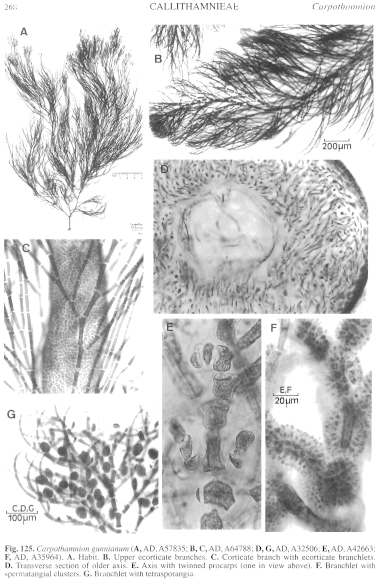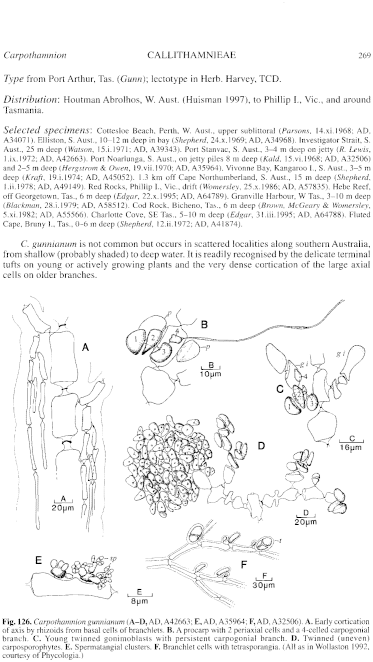|
|
|
|
|
|||||||||||
|
Electronic Flora of South Australia Species Fact Sheet
Phylum Rhodophyta – Order Ceramiales – Family Ceramiaceae – Tribe Callithamnieae
Selected citations: Huisman 1997: 196. Silva et al. 1996: 387.
Synonyms
Thamnocarpus gunnianus Harvey in W.J. Hooker 1844: pl. 662. J. Agardh 1851: 102; 1876: 82; 1897: 74. De Toni 1903: 1518. Harvey 1855a: 559; 1863, synop.: xlix. Hooker & Harvey 1847: 409. Huisman 1997: 196. Huisman & Walker 1990: 426. Kylin 1956: 397. Lucas 1909: 53; 1929a: 26. Lucas & Perrin 1947: 370. May 1965: 368. Mazza 1913: No. 455. Schmitz & Hauptfleisch 1897: 504. Sonder 1881: 12. Wollaston 1992: 140, figs 1–16.
Callithamnion penicillatum Harvey 1863: pl. 273.
Thamnocarpus penicillatus (Harvey) J. Agardh 1876: 83; 1897: 34. De Toni 1903: 1519. Lucas 1909: 53. Lucas & Perrin 1947: 370, fig. 187. Sonder 1881: 12.
Thamnocarpus harveyanus J. Agardh 1876: 82; 1897: 34. De Toni 1903: 1519. Lucas 1909: 53; 1929a: 26; 1929b: 53. Reinbold 1898: 52. Sonder 1881: 12.
Thallus (Fig. 125A) erect, dark red-brown, 4–32 cm high, cartilaginous with usually one irregularly branched axis and well developed lateral branches (Fig. 125B), becoming heavily corticated (Fig. 125C, D) from close to apices and 1–2 mm in diameter. Holdfast discoid, becoming hapteroid, 0.5–6 mm across, pseudoparenchymatous; epilithic. Structure. Apices when young (or proliferous from older branches) with alternately spirally branched filaments 1–2.5 (–4) mm long, forming apical tufts or short laterals (Fig. 125B) when undamaged but easily lost; cells of young axes 20–40 µm in diameter and L/D (0.5–) 1–2, lateral branchlets basally branched with long unbranched ends, 20–35 µm in diameter with cells L/D 3–5. Rhizoidal cortication (Fig. 126A) commencing close to branch apices from basal cells of determinate laterals, becoming dense and pseudoparenchymatous, with an outer layer of smaller cells; rhizoids 5–12 µm in diameter, cells L/D 4–10, outermost cells isodiametric, 4–8 µm across. The axial filament gradually enlarges to (150–) 250–500 µm in diameter, cells L/D 1–1.5 (–2), and remains very conspicuous in section of the branches. Cells uninucleate; rhodoplasts discoid to elongate.
Reproduction: Gametophytes dioecious. Procarps (Figs 125E, 126B) borne on axial cells of the ecorticate apical tufts, with two opposite periaxial cells often 2–3 axial cells apart. One periaxial bears a 4-celled carpogonial branch, and post-fertilization (Fig. 126C) each periaxial cuts off an auxiliary cell and fusion of the carpogonium with both occurs via connecting cells; twin gonimoblasts, each with a foot cell, are initiated, forming rounded, lobed, carposporophytes (Fig. 126D) 100–200 µm across with carposporangia 25–30 µm in diameter. Spermatangia (Figs 125F, 126E) occur in groups on cells of the branchlets, with clusters of initials producing about 4 cells each of which bears outwardly 3–4 spermatangia.
Tetrasporangia (Figs 125G, 126F) are borne on cells of the branchlets, singly or with a second younger one, sessile, ovoid, 30–45 µm in diameter, tetrahedrally divided.
Type from Port Arthur, Tas. (Gunn); lectotype in Herb. Harvey, TCD.
Selected specimens: Cottesloe Beach, Perth, W. Aust., upper sublittoral (Parsons, 14.xi.1968; AD, A34071). Elliston, S. Aust., 10–12 m deep in bay (Shepherd, 24.x.1969; AD, A34968). Investigator Strait, S. Aust., 25 m deep (Watson, 15.i.1971; AD, A39343). Port Stanvac, S. Aust., 3–4 m deep on jetty (R. Lewis, 1.ix.1972; AD, A42663). Port Noarlunga, S. Aust., on jetty piles 8 m deep (Kald, 15.vi.1968; AD, A32506) and 2–5 m deep (Hergstrom & Owen, 19.vii.1970; AD, A35964). Vivonne Bay, Kangaroo I., S. Aust., 3–5 m deep (Kraft, 19.i.1974; AD, A45052). 1.3 km off Cape Northumberland, S. Aust., 15 m deep (Shepherd, 1.ii.1978; AD, A49149). Red Rocks, Phillip I., Vic., drift (Womersley, 25.x.1986; AD, A57835). Hebe Reef, off Georgetown, Tas., 6 m deep (Edgar, 22.x.1995; AD, A64789). Granville Harbour, W Tas., 3–10 m deep (Blackman, 28.i.1979; AD, A58512). Cod Rock, Bicheno, Tas., 6 m deep (Brown, McGeary & Womersley, 5.xi.1982; AD, A55566). Charlotte Cove, SE Tas., 5–10 m deep (Edgar, 31.iii.1995; AD, A64788). Fluted Cape, Bruny I., Tas., 0–6 m deep (Shepherd, 12.ii.1972; AD, A41874).
Distribution: Houtman Abrolhos, W. Aust. (Huisman 1997), to Phillip I., Vic., and around Tasmania.
Taxonomic notes: C. gunnianum is not common but occurs in scattered localities along southern Australia, from shallow (probably shaded) to deep water. It is readily recognised by the delicate terminal tufts on young or actively growing plants and the very dense cortication of the large axial cells on older branches.
References:
AGARDH, J.G. (1851). Species Genera et Ordines Algarum. Vol. 2, Part 1, I-XII, 1–336 + index. (Gleerup: Lund.)
AGARDH, J.G. (1876). Species Genera et Ordines Algarum. Vol. 3, Part 1- Epicrisis systematic Floridearum, pp. i-vii, 1–724. (Weigel: Leipzig.)
AGARDH, J.G. (1897). Analecta Algologica. Cont. IV. Acta Univ. lund. 33, 1–106, Plates 1, 2.
DE TONI, G.B. (1903). Sylloge Algarum omnium hucusque Cognitarum. Vol. 4. Florideae. Sect. 3, pp. 775–1521 + 1523–1525. (Padua.)
HARVEY, W.H. (1855a). Some account of the marine botany of the colony of Western Australia. Trans. R. Jr. Acad. 22, 525–566.
HARVEY, W.H. (1863). Phycologia Australica. Vol. 5, Plates 241–300, synop., pp. i-lxxiii. (Reeve: London.)
HOOKER, J.D. & HARVEY, W.H. (1847). Algae Tasmanicae. Lond. J. Bot. 6, 397–417.
HOOKER, W.J. (1844). Icones plantarum. 3(2), i-viii, Plates 601–700.
HUISMAN, J.M. & WALKER, D.I. (1990). A catalogue of the marine plants of Rottnest Island, Western Australia, with notes on their distribution and biogeography. Kingia 1, 349–459.
HUISMAN, J.M. (1997). Marine Benthic Algae of the Houtman Abrolhos Islands, Western Australia. In Wells, F.E. (Ed.) The Marine Flora and Fauna of the Houtman Abrolhos Islands, Western Australia, pp. 177–237. (W. Aust. Museum: Perth.)
KÜTZING, F.T. (1849). Species Algarum. (Leipzig.)
KYLIN, H. (1956). Die Gattungen der Rhodophyceen. (Gleerups: Lund.)
LUCAS, A.H.S. & PERRIN, F. (1947). The Seaweeds of South Australia. Part 2. The Red Seaweeds. (Govt Printer: Adelaide.)
LUCAS, A.H.S. (1909). Revised list of the Fucoideae and Florideae of Australia. Proc. Linn. Soc. N.S.W. 34, 9–60.
LUCAS, A.H.S. (1929a). The marine algae of Tasmania. Pap. Proc. R. Soc. Tasm. 1928, 6–27.
LUCAS, A.H.S. (1929b). A census of the marine algae of South Australia. Trans. R. Soc. S. Aust. 53, 45–53.
MAY, V. (1965). A census and key to the species of Rhodophyceae (red algae) recorded from Australia. Contr. N.S.W. natn. Herb. 3, 349–429.
MAZZA, A. (1913). Saggio di Algologia Oceanica. Nuova Notarisia 24, Nos. 448–473.
REINBOLD, T. (1898). Die Algen der Lacepede und Guichen Bay (Slid Australien) und deren näherer Umgebung, gesammelt von Dr. A. Engelhart-Kingston. II. Nuova Notarisia 9, 33–54.
SCHMITZ, F. & HAUPTFLEISCH, P. (1897). Ceramiaceae. In Engler, A. & Prantl, K., Die natarlichen Pflanzenfamilien, Vol. 1, Part 2, pp. 481–504. (Leipzig.)
SILVA, P.C., BASSON, P.W. & MOE, R.L. (1996). Catalogue of the Benthic Marine Algae of the Indian Ocean. (University of California Press: Berkeley, Los Angeles & London.)
SONDER, O.W. (1881). In Mueller, F., Fragmenta Phytographiae Australiae. Supplementum ad volumen undecinum: Algae Australianae hactenus cognitae, pp. 1–42, 105–107. (Melbourne.)
WOLLASTON, E.M. (1992). Morphology and taxonomy of Thamnocarpus (Ceramiaceae, Rhodophyta) in southern Australia and east Africa. Phycologia 31, 138–146.
The Marine Benthic Flora of Southern Australia Part IIIC complete list of references.
Publication:
Womersley, H.B.S. (24 December, 1998)
The Marine Benthic Flora of Southern Australia
Rhodophyta. Part IIIC. Ceramiales – Ceramiaceae, Dasyaceae
©State Herbarium of South Australia, Government of South Australia
Illustrations in Womersley Part IIIA, 1998: FIGS 125, 126.

Figure 125 enlarge
Fig. 125. Carpothamnion gunnianum (A, AD, A57835; B, C, AD, A64788; D, G, AD, A32506; E, AD, A42663; F, AD, A35964). A. Habit. B. Upper ecorticate branches. C. Corticate branch with ecorticate branchlets. D. Transverse section of older axis. E. Axis with twinned procarps (one in view above). F. Branchlet with spermatangial clusters. G. Branchlet with tetrasporangia.

Figure 126 enlarge
Fig. 126. Carpothamnion gunnianum (A–D, AD, A42663; E, AD, A35964; F, AD, A32506). A. Early cortication of axis by rhizoids from basal cells of branchlets. B. A procarp with 2 periaxial cells and a 4-celled carpogonial branch. C. Young twinned gonimoblasts with persistent carpogonial branch. D. Twinned (uneven) carposporophytes. E. Spermatangial clusters. F. Branchlet cells with tetrasporangia. (All as in Wollaston 1992, courtesy of Phycologia.)

|
Email Contact: State Herbarium of South Australia |

|